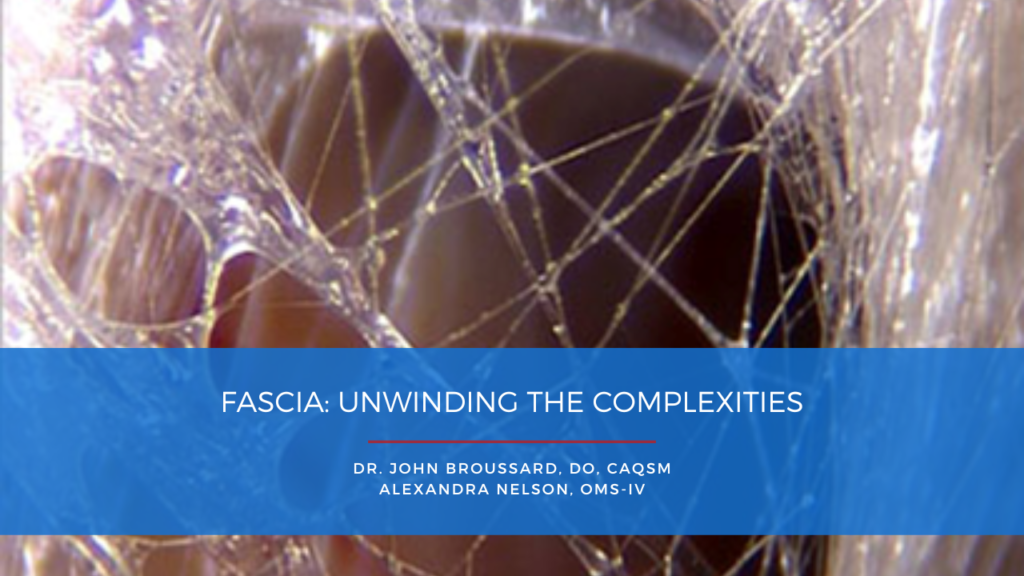What is Fascia?
There’s fascia, and then there’s the fascial system. At its core fascia is a connective tissue which helps to stabilize our body structures and allows for flexible, fluid motion. But on a grander scale, it is a vast interconnected structure which is often the root of musculoskeletal and sports-related injuries. The spider web-like intricate weaving of fascia allows for great structural strength and stability, but also offers many points for injury which can remain disguised for years at a time.
There are two main types of fascia: superficial and deep. Superficial fascia is fine in texture, and it drives a barrier between your skin and the muscle that lies underneath it. Deep fascia tends to be denser, and may either surround muscle fibers, viscera (your internal organs), or the inside of body cavities. Additionally, fascia helps keep our tendons, ligaments, and nerves protected and flexible.
Fascia is primarily made up of water, collagen, elastin, and hyaluronic acid. That’s right – the ingredient you’ll find in everything from skincare products to FDA-approved knee injections. Hyaluronic acid is a polysaccharide which works as a cushion in different areas of our body, helping to lubricate joints, bodily tissue, and our skin. As such, when fascia is healthy it is pliable, slippery, and stretches with our every movement. But when it is injured or otherwise unhealthy, fascia tends to thicken, become stickier, and bind upon itself causing all kinds of problems.


(Photo citations included in References section)
How do fascial injuries impact your performance?
As athletes, we constantly challenge our bodies to push new boundaries. Whether you’re an avid runner, weightlifter, gymnast, or pickleball connoisseur, fascia plays a crucial role in optimizing your performance. Naturally, if your fascia is weakened from disuse or from injury, you may begin to see decreased strength and power, worsened flexibility and range of motion, and you may be more prone to compounding injuries. When fascia becomes over-stretched, torn, or binds over itself, it is known as “fascial winding” or “fascial folding”.
If you touch one end of a spider’s web, you will notice ripples through the individual fibers, and the web will bound in a wave-like pattern up and down. Given the incredibly complex interwoven structure of the fascial planes, you can imagine how an injury in your lower extremity may cause more fascial winding up your IT band (which is one big ole’ chunk of fascia), into your pelvic and hip musculature, and throughout your lower back. While tears in the fascia may be localized, the effects of the injury tend to linger across a more significant area than one might expect.
Common Patterns of Injury
Most people are familiar with the concept of a muscle “knot”, and you can probably find several on your body right now! However, this is very likely not the actual muscle itself, but the fascia which surrounds and interlays throughout the muscle fibers.
Trigger points are like hard, small, and exquisitely painful “knots” which reside within the fascia of skeletal muscle, while trigger bands are distinguished patterns of fascial distortion which mimic a long, twisted rope. Many folks experience trigger bands which extend from the base of your head down around your shoulder blades.
Another universally-despised fascial injury is plantar fasciitis – over time, small tears form in the thick fascia which connects your heel bone to your toes. If you have heightened heel pain in the morning and engage in repetitive load-bearing exercise like long-distance running or dance, or work on your feet all day every day, this may be what’s plaguing your feet.


So, how can I fix this and get back to my routine?
Something important to note is that not all fascial injuries are created equally. Techniques like tissue massage can be wonderful options to alleviate pain, but they are more of a “Band-Aid” approach to a potentially long-term problem, especially if the fascia is torn significantly. The more complex the injury, the more important it is to target its root cause. With the advanced assistance of bedside ultrasound evaluation, we visualize your soft tissue and its surrounding fascia, and can diagnose incredibly small fascial injuries – even damage previously undetected by MRI.
Remember how we mentioned that fascia is primarily made up of water, hyaluronic acid, and fibrous connective materials like collagen? Several therapies that Alliance Regen & Rehab offer target these malleable materials, and have been helpful in permanently healing fascial injuries in countless of our patients: prolotherapy, platelet-rich plasma, hyaluronic acid injections, shockwave therapy, and osteopathic manipulative medicine.
- Prolotherapy, PRP, and HA injections all work in different ways, but similarly work to aggravate injured tissue and stimulate an immune response.
- Shockwave therapy creates percussive pressure (think a more intense Theragun, but with the added ability of reaching far deeper into your tissue).
- Osteopathic Manipulative Medicine (OMM) is a safe, effective, and hands-on approach to your recovery. Our physician Dr. John Broussard is a fellowship-trained Sports Medicine osteopathic physician, and is well-versed in OMM, including in the Fascial Distortion Model (FDM).
For further details on these treatments, feel free to check out our website at: https://thealliancerx.com/regenerative-medicine/.
Take Home Points
By incorporating fascial health into your regimen, you can enhance flexibility, strength, and resilience, ultimately pushing your athletic boundaries further. Techniques such as dynamic warmups and stretching can significantly reduce the potential for fascial injuries, as can foam rolling after an intense workout! Another helpful tip is to vary your exercises to avoid excessive, repetitive movements and strain on specific areas of fascia.
Fascial injuries can be devastating to athletes, and often go misdiagnosed and/or untreated for months to years. Going without proper diagnosis and treatment may exacerbate injuries over time and lessen one’s ability to properly recover.
That said, we understand that the typical experience of having your years-old sports injury examined can be frustrating, and it may be disheartening to not feel as though your concerns are being heard; rest assured that Alliance Regan & Rehab will genuinely take your health to heart and work avidly to get to the root of this problem. Your health, well-being, and recovery are of utmost importance to us.
Please feel free to share this article with friends or family, and reach out for a consultation with our doctors at: https://thealliancerx.com/speak-with-a-specialist/.
Articles/References
Fascial tissue research in sports medicine: from molecules to tissue adaptation, injury and diagnostics
- https://bjsm.bmj.com/content/bjsports/early/2018/08/14/bjsports-2018-099308.full.pdf
- This is a great open-access overview of the role of fascial treatment in sports medicine
Figure 1: Guimberteau, J. Living fascia [Photograph]. Body Basics MFR. http://bodybasicsmfr.com/wp-content/uploads/2012/08/fascia_up_close.jpg
Figure 2: Staffotos, F. (2007). Spider web with dew drops 03 [Photograph]. Wikimedia. https://commons.wikimedia.org/wiki/File:Spider_web_with_dew_drops03.jpg
Figure 3: Trigger Points [Photograph]. Swedish Institute. https://www.swedishinstitute.edu/wp-content/webp-express/webp-images/doc-root/wp-content/uploads/2019/03/Trigger-Points-CROPPED.jpg.webp
Figure 4: Plantar Fasciitis with Text [Photograph]. Arthrohab. https://athrohab.co.uk/wp-content/uploads/2019/06/plantar-fasciitis-with-text.jpg



I love your writing style! It’s engaging and easy to understand, even for someone new to massage therapy.